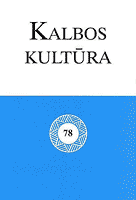Jungtukų ir jungiamųjų žodžių vartojimo dažnis sakytinėje kalboje
Frequency of conjunctions and conjunctives in the spoken discourse of live television talk shows
Author(s): Lina MurinienėSubject(s): Language and Literature Studies
Published by: Lietuvių Kalbos Institutas
Keywords: Conjunctions; conjunctives; spoken discourse; frequency
Summary/Abstract: The paper focuses o the language of live television talk shows. An attempt has been made to study the transcripts of the show texts (110 490 words altogether). All occurrences of the conjunctions and conjunctives were counted. The research results have identified the most frequent means of connection: ir, kad, kuris/i, o, kaip, bet, tai, jeigu, kai, nes ('and, that, who, however, as, but, thus, if, when, because'). Lyg, tarsi, jog, kur, tarytum ('as if, as, that, where, like') are among the least frequent means. A contrast in the spoken discourse is more frequently expressed by the conjunctions bet ('but') and o ('however'); hardly ever by tačiau. The conjunction bei ('and') manifests a link with the written language, since it is more frequent (and irregular) in the rehearsed or reviewed shows with an obvious preparation stage. The causal conjunction nes ('because') is more frequent than kadangi ('whereas'). The majority of subordinate clauses with the conjunction kadangi in the speech of politicians and physicians occur after an independent clause. In standard Lithuanian it is usually evaluated as less preferred. The use of tuo tarpu ('meanwhile') as a junction between sentences in the publication Kalbos patarimai has been quite problematic and would require further research. The function of tuo tarpu is likely to be the same or similar to that of the conjunctions o and bet; however, tuo tarpu cannot replace them in all cases.
Journal: Bendrinė kalba (iki 2014 metų – Kalbos kultūra)
- Issue Year: 2005
- Issue No: 78
- Page Range: 162-170
- Page Count: 9
- Language: Lithuanian

